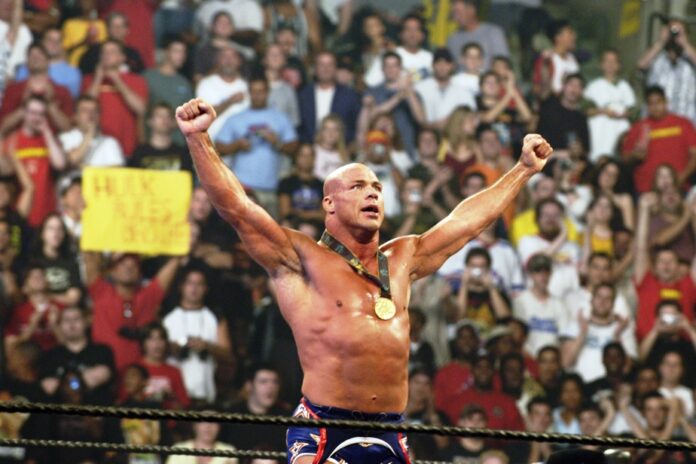January 2000. The WWF holds the Royal Rumble, an annual classic, at Madison Square Garden, essentially its home. It’s where many of the most important shows in the company’s history have taken place, and it’s where the keenest fans can be found. This is New York and everything that comes with it.
Anyone who knows the slightest bit about wrestling knows how crucial the first fight of a night is, in order to set the tone, to stimulate the spectators. It is the equivalent of the first appearance in a hockey game. And it is to Kurt Angle, then a rookie who has been wrestling in the WWF for only two months, that we entrust the task of launching hostilities. His fight pits him against Tazz, a local legend who landed in the WWF from ECW, another organization.
The fight barely lasts three minutes, but spectators get what they pay for and roar from start to finish. Tazz won the fight, “handling” Angle his first loss in the WWF.
“I felt good, the company trusted me against the biggest name in ECW. I lost, but it was a great way to launch Tazz’s career with us,” Angle said today.
A few years earlier, Angle would never have said that. His past as an Olympic wrestler led him to look down on professional wrestling, with its choreography, chair beatings and tricks.
Vince McMahon, owner of the WWF, is then in constant search of future stars, he who has lost one and another, in particular Hulk Hogan, at the hands of his direct competitor, WCW. In particular, he urges two American Olympic athletes, Angle and weightlifter Mark Henry.
“After the Games, Vince invited me to WWF Headquarters to offer me a 10-year, multi-million dollar contract. I didn’t know how to react, I had never made any money before! But I didn’t understand wrestling, I wasn’t a fan. I said to him, “I’m an Olympic champion, you have to promise me that I’ll never lose.” He said, “No need to call us, we’ll call you back!” Angle laughs on the line.
“So I talk to my agent about it, and he throws the contract in the trash. He himself was a former amateur wrestler. He said to me, “You do real wrestling, they do fake fights. Forget it, I’ll find you something else.” »
The agent keeps his word and does find him something else: a job as a newsreader at a local station in Pittsburgh on weekends.
“But I’ve never been very good. After a year, I let go, I called the WWF to find out if the offer was still on the table. They said, ‘No, but you can come and have a try.’ »
The rest, our English-speaking friends would say, is history.
Angle enjoyed a meteoric rise in what later became WWE and was a four-time heavyweight champion. He quickly earned the respect of fans by his ability to deliver thrilling fights. His backflips seemed to be produced by artificial intelligence, they were so fluid. In 2001, he even attempted one from the top of a cage; his opponent had withdrawn.
Angle also quickly earned the respect of WWE executives. In 2002, when a promising wrestler by the name of John Cena was ready for the big leagues, it was with Kurt Angle that he fought his first fight.
He accomplished all this not without losing fights along the way, which he thought was unthinkable when he was carrying his freshly won Olympic medal.
He thanks Dory Funk Jr. and Tom Pritchard – the brother of the inimitable Brother Love – for teaching him the importance of defeat.
“They taught me the psychology of wrestling. A wrestler must win to build a character. But to win, you have to beat other wrestlers. In losing, you have to highlight your opponent. Since I was an Olympic gold medalist, an opponent who beat me had something to brag about! »
By the time Quebecers Kevin Owens and Sami Zayn took WWE by storm, Angle was slowing down in the arena and wrestling sporadically. So he never fought with them. He did, however, interact with them a few times on the mic. “They are so talented. It’s crazy how many Canadian wrestlers have had amazing careers. It’s crazy. Kevin and Sami don’t look like your typical wrestlers. Kevin is slightly overweight, Sami is skinny, but they are so talented that they have become popular. When you think of a wrestler, you think of a bodybuilder, not guys like them! »
Kurt Angle does not have tons of stories to tell related to Montreal. He fought a dozen times in the metropolis, but never delivered memorable fights there, he who nevertheless produced dozens of epic battles. However, he has a history with one of the greatest sportsmen here: Mario Lemieux. Angle is from Pittsburgh and when he became an Olympic champion, he started getting various invites to local celebrity events. So that’s when he started breathing the same air as 66. “He invited me to his golf tournament and I was really bad!” I haven’t seen him less in recent years, but last year I went to a game in Pittsburgh and my box was next to his, so we talked a little. Angle is adamant about Lemieux’s legacy: “He’s the biggest name in the history of the sport in Pittsburgh. Maybe bigger than Terry Bradshaw. Let’s not forget what he did: charities, sports complexes. He wasn’t just an athlete, he did so much more. »





